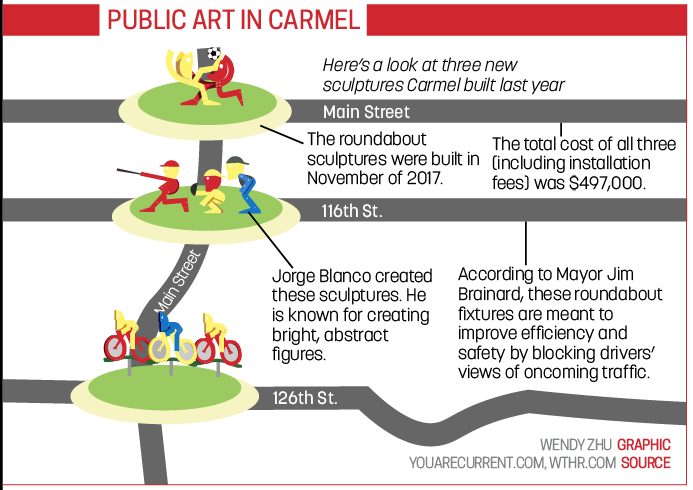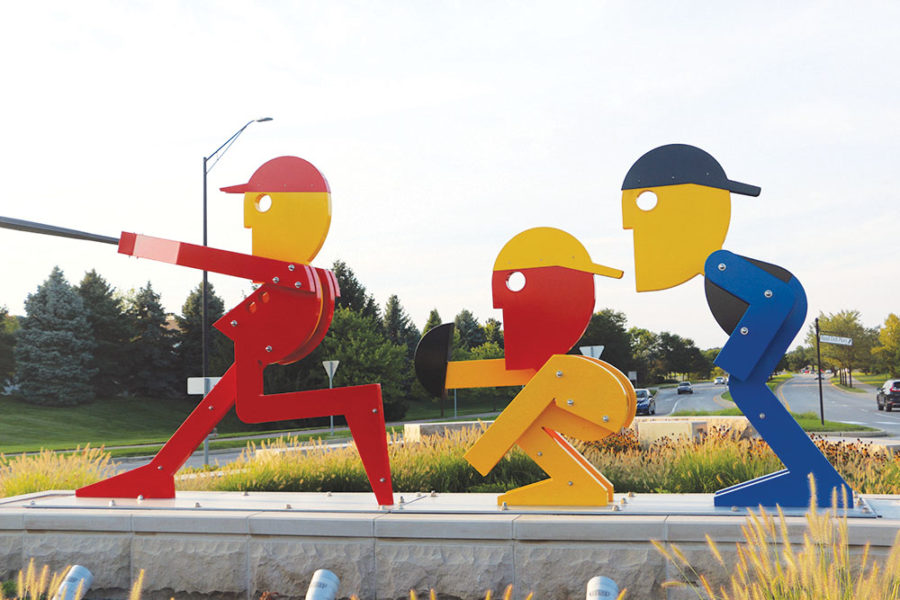After living in Carmel, a city well-known for frequent construction and dedication to improvement, the recent installment of new pieces of public art in the center of roundabouts came as no surprise to junior Vivian Werstler. From depictions of figures playing sports such as soccer and baseball to abstract sculptures, these new art pieces seem to be the latest project for members of city government in their continued search for enhancement. For the most part, citizens seem to applaud the dedication. Werstler, an artist living right next to the Hazel Dell roundabout with a statue of figures playing soccer, is one of these Carmel citizens who appear to be on board for the renovations.
Werstler said, “I think (the public art roundabout pieces) are a fun new addition because the roundabouts were pretty boring before. You would just be driving your car with nothing to see, and now you can see really cool representations of figures playing sports.”
According to Carmel Mayor Jim Brainard, the visual aesthetic of the various sculptures plays a major role in the reasoning behind the installments.
Brainard said via email, “The decorative landscaping and beautiful artwork adds to the overall beauty of a drive through Carmel, which adds to the quality of life experienced by our residents as they commute to and from various places. This quality of life is a key part to our success in attracting new companies and a highly-educated workforce.”
While creating art with visual appeal was the main goal, there are still many citizens who said they feel unsatisfied with the new additions. Among them is junior Natalie Crispin, who said she wishes the city had left the natural landscapes that used to reside in the center of roundabouts.
“A lot more people enjoy looking at (flowers and trees) rather than random statues that have no meaning and are not very visually appealing,” Crispin said.
Aesthetics aside, there are other important considerations when it comes to evaluating these artistic additions. According to Fox59 News, the three sport-playing sculptures that now stand in the middle of three separate roundabouts cost $487,000 in total with an additional $10,000 for installation, what may appear to some citizens as an excessive amount of money to spend on art pieces such as these. Brainard, however, said Carmel citizens have some of the lowest property taxes in the state, a fact, he said, that softens the burden of these costs.
“We feel confident that our investment into cultural arts of all kinds is not only affordable but good for the city and helps us attract business investment which keeps our taxes low,” Brainard said.
For the citizens who support the sculptures, the additional costs do not make the art any less appealing.
Werstler said, “Obviously, if people have no interest in art then they probably don’t want to pay for these statues, but I do think it’s worth it because it makes Carmel unique. These (roundabouts) are something new that you don’t see very often.”
To add backing to Werstler’s stance, in an article written by Paul Konz and published by the National League of Cities, Konz found that investment in culture and the arts are more economically beneficial to a city than even tourism or transportation. In their 2017 State of Cities report, they found that for every dollar a city invests into public art, there are $6 in taxes produced. Not only this, but the arts have shown to improve almost all city issues such as public safety, infrastructure, and health.
Brainard said, “The world’s great cities have always focused on beauty and public art throughout history, for example, Florence, Paris and Rome. We also realize the tremendous impact that the arts have on economic development. By investing in features such as these pieces of art and decorative landscaping, we are investing in our city. It’s a nice feeling when you see this level of art on public display; it adds value to the investments that we all make on our homes, businesses and other things that go along with living, working and playing in Carmel.”
Werstler said she fears members of city government will not continue to establish art pieces such as these because of negative societal responses; however, many other citizens, such as Crispin, said they believe local government will pursue these artistic advancements further, as evidenced by the recent addition of the greyhound cut-outs lining another roundabout on Main Street. Whether the majority of people enjoy the new sculptures or not, Carmel’s government stands firm on its dedication to the arts.
“A city that values the arts,” Brainard said, “is a city that values happiness, creativity and cultural expansion and expression.”

































![AI in films like "The Brutalist" is convenient, but shouldn’t take priority [opinion]](https://hilite.org/wp-content/uploads/2025/02/catherine-cover-1200x471.jpg)









































![Review: “The Immortal Soul Salvage Yard:” A criminally underrated poetry collection [MUSE]](https://hilite.org/wp-content/uploads/2025/03/71cju6TvqmL._AC_UF10001000_QL80_.jpg)
![Review: "Dog Man" is Unapologetically Chaotic [MUSE]](https://hilite.org/wp-content/uploads/2025/03/dogman-1200x700.jpg)
![Review: "Ne Zha 2": The WeChat family reunion I didn’t know I needed [MUSE]](https://hilite.org/wp-content/uploads/2025/03/unnamed-4.png)
![Review in Print: Maripaz Villar brings a delightfully unique style to the world of WEBTOON [MUSE]](https://hilite.org/wp-content/uploads/2023/12/maripazcover-1200x960.jpg)
![Review: “The Sword of Kaigen” is a masterpiece [MUSE]](https://hilite.org/wp-content/uploads/2023/11/Screenshot-2023-11-26-201051.png)
![Review: Gateron Oil Kings, great linear switches, okay price [MUSE]](https://hilite.org/wp-content/uploads/2023/11/Screenshot-2023-11-26-200553.png)
![Review: “A Haunting in Venice” is a significant improvement from other Agatha Christie adaptations [MUSE]](https://hilite.org/wp-content/uploads/2023/11/e7ee2938a6d422669771bce6d8088521.jpg)
![Review: A Thanksgiving story from elementary school, still just as interesting [MUSE]](https://hilite.org/wp-content/uploads/2023/11/Screenshot-2023-11-26-195514-987x1200.png)
![Review: "When I Fly Towards You", cute, uplifting youth drama [MUSE]](https://hilite.org/wp-content/uploads/2023/09/When-I-Fly-Towards-You-Chinese-drama.png)
![Postcards from Muse: Hawaii Travel Diary [MUSE]](https://hilite.org/wp-content/uploads/2023/09/My-project-1-1200x1200.jpg)
![Review: "Ladybug & Cat Noir: The Movie," departure from original show [MUSE]](https://hilite.org/wp-content/uploads/2023/09/Ladybug__Cat_Noir_-_The_Movie_poster.jpg)
![Review in Print: "Hidden Love" is the cute, uplifting drama everyone needs [MUSE]](https://hilite.org/wp-content/uploads/2023/09/hiddenlovecover-e1693597208225-1030x1200.png)
![Review in Print: "Heartstopper" is the heartwarming queer romance we all need [MUSE]](https://hilite.org/wp-content/uploads/2023/08/museheartstoppercover-1200x654.png)



